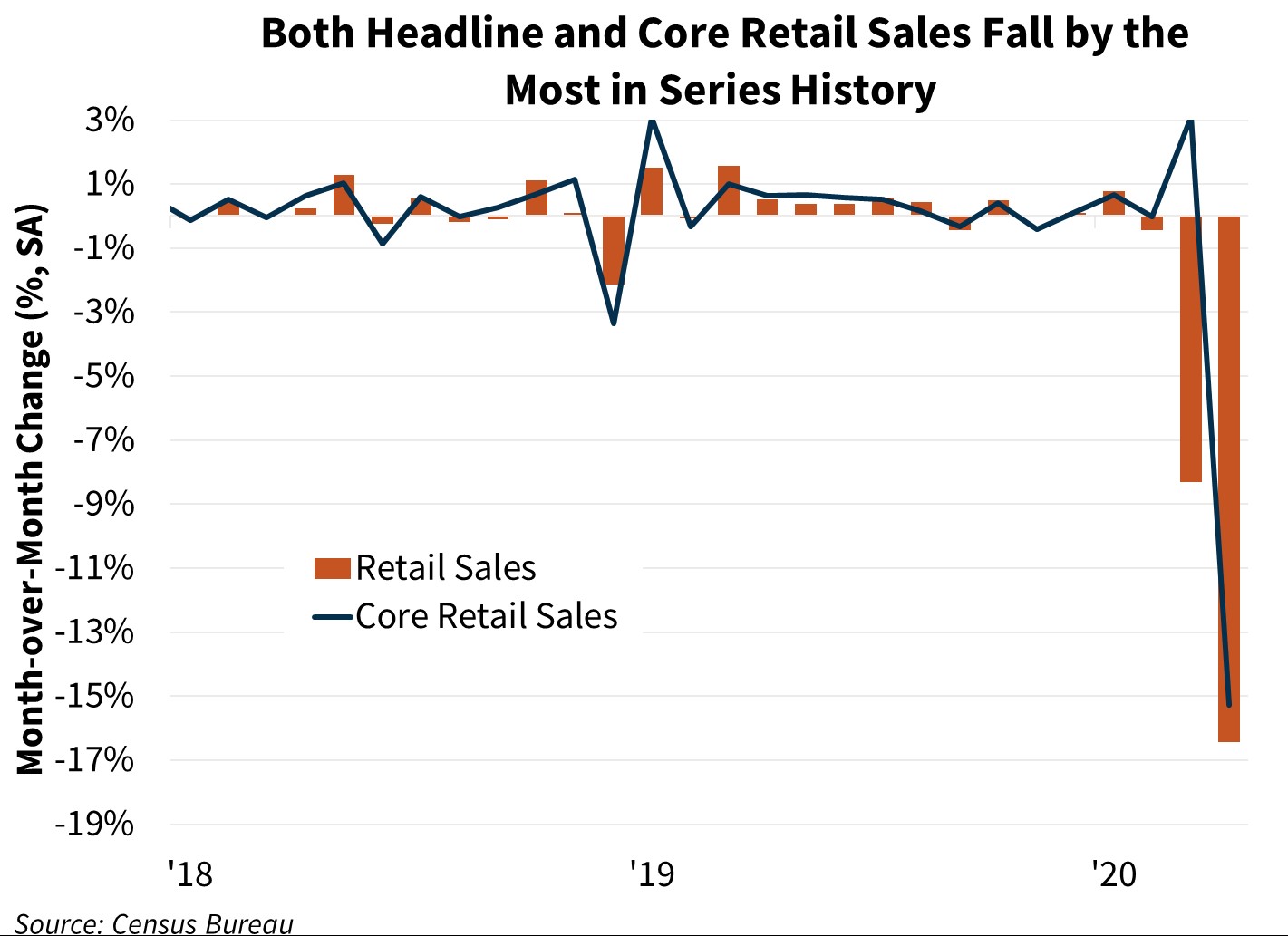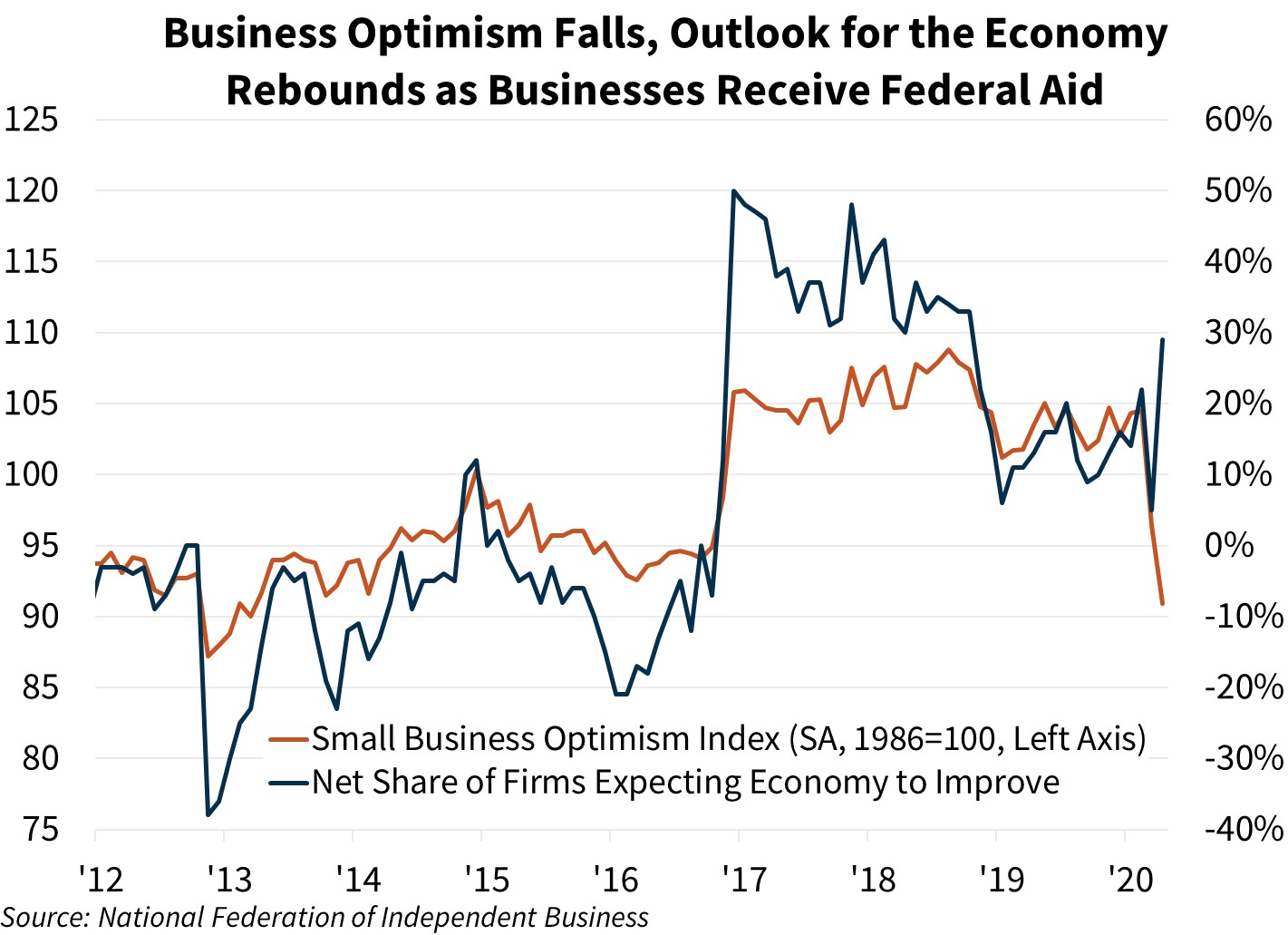Retail Sales Continue to Fall, Supporting Our Forecast of a Significant Contraction in Q2 Consumer Spending
Key Takeaways:
- Retail sales and food services fell 16.4 percent in April, the largest decline since the series began in 1967, driven by significant declines in sales at home furniture and appliance stores and clothing stores. Sales at food and beverage stores fell 13.1 percent, a sharp pull back from the surge seen last month as the initial pandemic-driven panic buying at grocery stores subsided. Core retail sales (excluding food services, auto, building supplies, and gas stations) also posted the largest decline in series history.
- Industrial production, a gauge of output in the manufacturing, utility, and mining sectors, fell 11.2 percent in April, the largest monthly decline in the series’ 100-year history. Manufacturing output dropped 13.7 percent, its largest decline on record, driven partially by the output of motor vehicles and parts falling more than 70 percent.
- The University of Michigan Consumer Sentiment Index ticked up 1.9 points in the preliminary May reading to 73.7. This was driven entirely by a rebound in the current economic conditions index, which posted the largest monthly increase since 2013. Inflation expectations for the next year jumped nine-tenths to 3.0 percent, the largest increase in over nine years, reaching its highest reading since August 2018.
- The National Federation of Independent Business (NFIB) Small Business Optimism Index fell 5.5 points in April to 90.9, the lowest level in over seven years. However, the net share of firms expecting the economy to improve jumped by 24 percentage points to 29 percent, the largest increase since December 2016.
- From a year ago, headline CPI rose 0.3 percent in April, the slowest pace since October 2015, dragged on by a 32 percent annual decline in gasoline prices. Core CPI rose 1.4 percent year over year, the slowest pace of growth in nine years.
- Mortgage applications edged up 0.3 percent for the week ending May 8, according to the Mortgage Bankers Association. Purchase applications jumped 10.6 percent, rising for a fourth consecutive week to the highest level in two months. Refinance applications continued to trend downward, falling 3.3 percent.
- The Mortgage Bankers Association National Delinquency Survey for Q1 2020 showed that the delinquency rate for mortgage loans on one-to-four-unit residential properties rose 59 basis points to a seasonally adjusted rate of 4.36 percent, the largest one-quarter increase since the hurricane-driven spike in Q3 2017. According to the press release, “it is clear the COVID-19 pandemic is impacting homeowners…and with signs of economic distress continuing into the second quarter, mortgage delinquencies will likely further increase.”
Forecast Impact
The sharp drop in April retail sales, and particularly in core retail sales, supports our expectation of a significant decline in consumer spending in the second quarter. As states begin to reopen, retail sales will likely improve slightly from current levels, though any rebound is unlikely to offset much of the decline seen in April. The slight increase in consumer sentiment in early May was likely due to many consumers receiving federal aid, either through the stimulus check, increased unemployment benefits, or both, which could help support retail sales in May. Both the historic decline in industrial production, particularly in manufacturing and mining, and the sharp drop in business optimism in April support our forecast of a steep decline in business investment in the second quarter. The decline in mining output is likely a result of the drop in crude oil prices, with overall energy prices falling sharply. However, the net share of firms expecting the economy to improve jumped in April, likely reflecting the optimism of firms as some states begin to reopen, along with many firms having received assistance from the federal government. In housing, the continued rise in purchase applications may suggest that the trough in sales activity has already occurred and is now on the upswing. Mortgage delinquencies rose in the first quarter and will likely rise further in the coming months as unemployment remains elevated and layoffs continue.


Details on Key Takeaways and Other Releases
- Retail sales and food services fell 16.4 percent in April, according to the Census Bureau. Excluding motor vehicles and parts, retail sales fell 17.2 percent. Sales at home furniture and appliance stores and clothing stores dropped 59.6 percent and 78.8 percent, respectively, while sales at building supply stores fell 3.5 percent. Sales at gas stations fell by 28.8 percent, the largest decline since tracking began in 1992. Core retail sales fell 15.3 percent, though sales at nonstore retailers jumped 8.4 percent, the largest increase since January 2019.
- Industrial production fell 11.2 percent in April according to the Federal Reserve Board. Mining output fell 6.1 percent, the largest decline since September 2008, while utilities output fell 0.9 percent. The capacity utilization rate—a measure of slack in the industrial sector—fell 8.3 percentage points to 64.9 percent, the lowest in series history.
- The University of Michigan Consumer Sentiment Index ticked up 1.9 points in the preliminary May reading to 73.7. The current economic conditions index rose 8.7 points to 83.0. The consumer expectations index fell 2.4 points to 67.7, the lowest reading since November 2013. Inflation expectations for the next five years rose one-tenth to 2.6 percent.
- The NFIB Small Business Optimism Index fell 5.5 points in April to 90.9. The net share of firms planning on increasing employment fell 8 percentage points to just 1 percent. The net share of firms expecting real sales to be higher fell 30 percentage points to negative 42 percent, the lowest share in the survey’s 46-year history. According to a separate May 1 survey from the NFIB, around 61 percent of Paycheck Protection Program (PPP) loan applicants have received their loan.
- The MBA National Delinquency Survey for Q1 2020 showed that the percentage of loans on which foreclosure actions were started fell to 0.19 percent. The survey also showed that the serious delinquency rate (the percentage of loans that are 90 days or more past due or in the process of foreclosure, not seasonally adjusted) fell 9 basis points from the prior quarter to 1.67 percent, 29 basis points below the rate from a year ago and the lowest level since Q2 2000.
Economic and Strategic Research Group
May 15, 2020
Opinions, analyses, estimates, forecasts and other views of Fannie Mae's Economic and Strategic Research (ESR) Group included in these materials should not be construed as indicating Fannie Mae's business prospects or expected results, are based on a number of assumptions, and are subject to change without notice. How this information affects Fannie Mae will depend on many factors. Although the ESR group bases its opinions, analyses, estimates, forecasts and other views on information it considers reliable, it does not guarantee that the information provided in these materials is accurate, current or suitable for any particular purpose. Changes in the assumptions or the information underlying these views, including assumptions about the duration and magnitude of shutdowns and social distancing, could produce materially different results. The analyses, opinions, estimates, forecasts and other views published by the ESR group represent the views of that group as of the date indicated and do not necessarily represent the views of Fannie Mae or its management.
